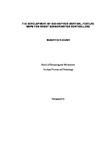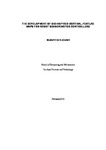The Development of Bio-Inspired Cortical Feature Maps for Robot Sensorimotor Controllers
| dc.contributor.supervisor | Culverhouse, Phil | |
| dc.contributor.author | Adams, Samantha | |
| dc.contributor.other | School of Engineering, Computing and Mathematics | en_US |
| dc.date.accessioned | 2013-05-14T10:55:39Z | |
| dc.date.available | 2013-05-14T10:55:39Z | |
| dc.date.issued | 2013 | |
| dc.date.issued | 2013 | |
| dc.identifier | 10148014 | en_US |
| dc.identifier.uri | http://hdl.handle.net/10026.1/1464 | |
| dc.description | Full version unavailable due to 3rd party copyright restrictions. | |
| dc.description.abstract |
This project applies principles from the field of Computational Neuroscience to Robotics research, in particular to develop systems inspired by how nature manages to solve sensorimotor coordination tasks. The overall aim has been to build a self-organising sensorimotor system using biologically inspired techniques based upon human cortical development which can in the future be implemented in neuromorphic hardware. This can then deliver the benefits of low power consumption and real time operation but with flexible learning onboard autonomous robots. A core principle is the Self-Organising Feature Map which is based upon the theory of how 2D maps develop in real cortex to represent complex information from the environment. A framework for developing feature maps for both motor and visual directional selectivity representing eight different directions of motion is described as well as how they can be coupled together to make a basic visuomotor system. In contrast to many previous works which use artificially generated visual inputs (for example, image sequences of oriented moving bars or mathematically generated Gaussian bars) a novel feature of the current work is that the visual input is generated by a DVS 128 silicon retina camera which is a neuromorphic device and produces spike events in a frame-free way. One of the main contributions of this work has been to develop a method of autonomous regulation of the map development process which adapts the learning dependent upon input activity. The main results show that distinct directionally selective maps for both the motor and visual modalities are produced under a range of experimental scenarios. The adaptive learning process successfully controls the rate of learning in both motor and visual map development and is used to indicate when sufficient patterns have been presented, thus avoiding the need to define in advance the quantity and range of training data. The coupling training experiments show that the visual input learns to modulate the original motor map response, creating a new visual-motor topological map. | en_US |
| dc.description.sponsorship | EPSRC, University of Plymouth Graduate School | en_US |
| dc.language.iso | en | en_US |
| dc.publisher | University of Plymouth | en_US |
| dc.subject | Spiking SOM | |
| dc.subject | Adaptive Plasticity | |
| dc.subject | Robotics | |
| dc.subject | Biologically Inspired | en_US |
| dc.title | The Development of Bio-Inspired Cortical Feature Maps for Robot Sensorimotor Controllers | en_US |
| dc.type | Thesis | |
| plymouth.version | Edited version | en_US |
| dc.identifier.doi | http://dx.doi.org/10.24382/4850 |
Files in this item
This item appears in the following Collection(s)
-
01 Research Theses Main Collection
Research Theses Main



